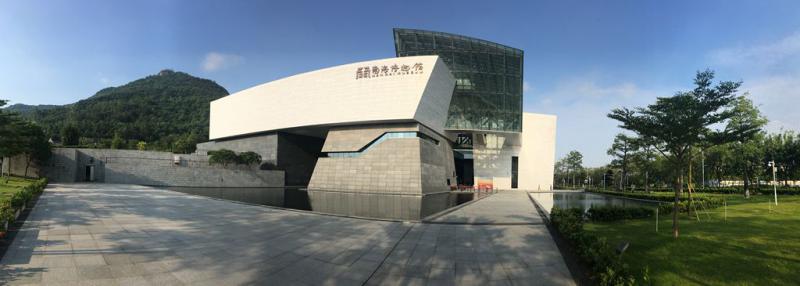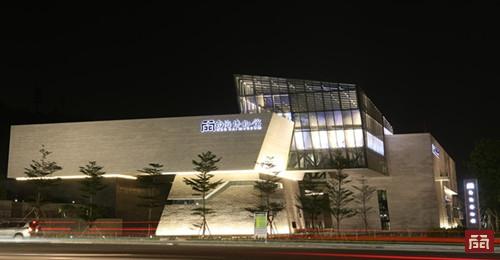PROFILE
Institutional profile
The Nanhai County Museum was established on June 18, 1981. The site is located in Yunquanxian, Baiyundong, Xiqiao Mountain. In July 1987, the Nanhai County Museum was moved from Yunquanxian to the Longdong, Xiqiao Mountain. On August 4, 2006, affected by the typhoon "Pei Bian", there was a rare mudslide disaster in Xiqiao Mountain. The site of the museum in Nanhai District was seriously damaged, and then moved to the former Nanhai Broadcasting and Television Bureau, No. 5, South Xinsan Road, Guicheng. The former site is used as a temporary office space. On November 20, 2008, the Nanhai District Museum Relocation Project was approved by the Nanhai District Development and Reform Bureau. The architectural design unit is Guangzhou Design Institute and Foshan Lingnan Architectural Design Consulting Co., Ltd. On January 16, 2010, the new building was started, and it was officially opened on December 18, 2013. The Nanhai District Museum is a comprehensive fund-raising institution directly under the district. It is a comprehensive museum integrating collection, protection, research, display and academic exchange. It is a patriotic education base of Foshan City and a demonstration base for science popularization in Foshan. An important place to display the history and culture of the South China Sea, the culture of Xiqiao Mountain and the culture of Guangfu.

The Nanhai District Museum covers an area of 3,4396.7 square meters and has a total construction area of 1,4559.7 square meters. It is located on the east side of the entrance to the south gate of Xiqiao Mountain, Xiqiao Town, Nanhai District, Foshan City. It is surrounded by beautiful scenery and deep Xiqiao Mountain. Xiqiao Dream Workshop, Guoyi Film and Television City, the environment is elegant, and the natural conditions are superior. It is a beautiful business card for the construction of the Wennan Mountain in the South China Sea.
The architectural design of the Nanhai Museum draws inspiration from the ancient quasi-stone quarries such as the Shiyanyan and Dripyan rocks in the Xiqiao Mountain area. The building's volume is criss-crossed and stacked to form a pile of stones and stacked rocks. Imagery, metaphorizing the ancient quarrying culture of the South China Sea, cleverly realized the unity of nature and art, history and modernity, sparked people's recollection of the history of the South China Sea, and produced a strong sense of local cultural identity.
The main building of the whole building has three floors. The first floor is the lobby, equipment room and temporary exhibition hall. The second floor is the office area, which includes the business department and the scientific research management room, and the third floor is the exhibition area. There are a total of seven permanent exhibition halls in the new building, namely, "South China Sea Memory", "Nanhai Qunying", "Library Paintings and Paintings", "Guangfu Style", Temporary Exhibition Hall and "Shijingyi Collection Exhibition" (including Exhibition Hall 1, Exhibition Hall 2), exhibition area A total of about 3,700 square meters.
As of December 31, 2017, the total number of collections in the collection is 10,208 (sets), and there are 23,695 collections, including 24 (two) sets of second-level cultural relics, 670 (sets) of third-level cultural relics, and the remaining 9514 (sets). General collection. The collections are mainly for the collection of cultural relics unearthed in the South China Sea, such as the Han Dynasty pottery, the Tang and Song dynasties, the Xiqiao Mountain ruins, and the works of the Nanhai dynasty. The Xiqiao Mountain ruins are the most distinctive features of calligraphy and letter manuscripts.
As of December 31, 2017, the total number of employees in the Nanhai District Museum was 137, consisting of 40 in-house staff and 97 property companies. Among the incumbents of the museum, the number of business personnel is 23, and there are 4 Chinese research associates, 4 Wenbo librarians, 8 Wenbo assistant librarians, 4 new professional and technical personnel, and 3 full-time management staff. The number of members is 17, including 3 computer technology network engineers and information system management engineers. Among the incumbents, there are 5 graduate students, 32 undergraduate degrees, and 3 junior college graduates. The museum is divided into functional departments such as the General Department, the Collection Research Department, the Exhibition and Mission Department, the Non-legacy Protection Department, and the Cultural Relics Protection Department.
The Nanhai District Museum is also responsible for the daily open management of the Dr. Shi Jingyi Museum, the Chen Qizhen Memorial Hall and the Kang Youwei Museum.

The Dr. Shi Jingyi Museum is located on the east side of the entrance to the south gate of Xiqiao Mountain, Xiqiao Town, Nanhai District, Foshan City, Guangdong Province, and is integrated with the Nanhai Museum. Among them, Dr. Shi Jingyi's museum covers an area of 2,800 square meters and is located on the first and second floors. The main functional areas are: entrance hall, exhibition hall, courtyard garden, cultural relics warehouse, main room and office area. The permanent exhibition "Shi Jingyi Collection Exhibition" is located on the first and second floors. The museum was started on January 16, 2010. On June 22, 2011, the main building was capped and opened on March 28, 2014. "Shi Jingyi Collection Exhibition" mainly promotes the extraordinary life of Shi Jingyi's patriotic love of the country and the gift of the book to the country. The exhibition establishes a modern display concept, and demonstrates the means to break through the traditional text picture and explanation. Through the comprehensive application of physical objects, graphics, painting, TV, film and television technology, multimedia technology, etc., the exhibition shows Dr. Shi Jingyi's collection. The contents of the exhibition are divided into two parts: “Gifts to the Country” and “Dr. Shi Jingyi's Treasures”. The “Gifts to the Country” section shows Dr. Shi Jingyi as the “first person to open cross-strait cultural exchanges”, “the talented person in culture” and “cultural books”. The historical performance of “History of Shijingyi” is divided into three parts: “National Baby Ye Jing”, “Contemporary Calligraphy Art Boutique” and “Craft Craftsmanship”, which showcases the rich cultural and artistic treasures of Dr. Shi Jingyi’s lifelong collection.
The Chen Qizhen Memorial Hall is located in Chengong Temple, Yuting, Jiancun Village, Xiqiao Town, Nanhai District, Foshan City, Guangdong Province. Yanting Chen Gongyu was built in the 13th year of Qing Guangxu (1887). It was repaired in 2002 and took the southeast to the northwest. Guangsan Road, the middle road three in two. The head door is used for meeting events, and the back hall is dedicated to the ancestors, with a carved gray marble stone building in the middle, and the carving is fine. Covers an area of 1,500 square meters, construction area of 600 square meters. The memorial hall contains "Chen Qizhen's Life History Exhibition", which shows Chen Qizhen's patriotism and love for his hometown. In 2002, Yuting Chen Gongyu was listed as the fourth batch of cultural relics protection units in Guangdong Province. In 2009, Chen Qizhen Memorial Hall was listed as the third batch of patriotic education bases in Foshan City.
Kang Youwei Museum is located in Su Village, Danzao Town, Nanhai District, Foshan City, Guangdong Province, including the former residence of Kang Youwei, Kang Youwei Museum and Nanhai Guild Hall. Kang Youwei's former residence is located in Su Village, Danzao Town, Nanhai District, Foshan City, Guangdong Province. It was originally called “Yanxiang Old House”. It is a three-storey two-column hard-topped ear-house building in the Qing Dynasty with a construction area of about 81 square meters. On March 19, 1858, Kang Youwei was born here. In Su Village, Kang Youwei has read a lot of books and spent the important youth stage of his life. In 1996, it was listed as a national key cultural relics protection unit. Kang Youwei's former residence and memorial hall are Foshan patriotism education base and Guangdong patriotism education base. The Kang Youwei Museum is a celebrity pavilion built to commemorate the famous Chinese modern sports leader Kang Youwei. Construction began in June 2014 and was completed in March 2018. The building has two floors, covering an area of about 1600 square meters and a building area of about 3,200 square meters. There is a exhibition of Kang Youwei's Life in the museum. The Nanhai Guild Hall is adjacent to the newly-built Kang Youwei Museum and is adjacent to Yinheyong in the west. It was started in June 2014 and was completed in March 2018. It covers an area of 4,300 square meters and has a construction area of 2,200 square meters. It is based on the Beijing Nanhai Guild Hall. Built in the west, facing the east, and juxtaposed four groups of courtyards, reappearing the style of the Beijing Nanhai Guild Hall. The Nanhai Guild Hall has two basic exhibitions, "Beijing Nanhai Guild Exhibition" and "Nanhai Keju Celebrity Exhibition".
